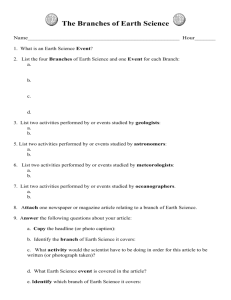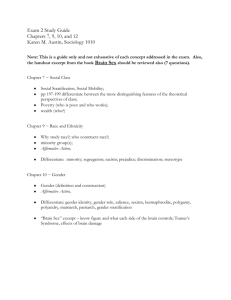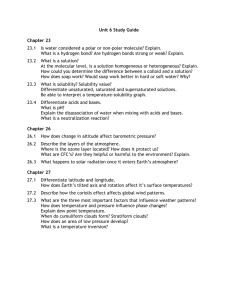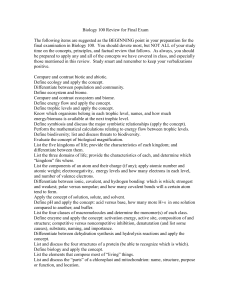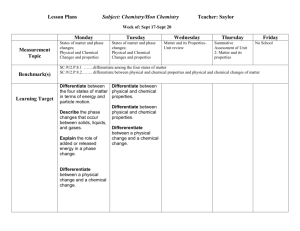Pre AP BIOLOGY FINAL EXAM REVIEW SHEET
advertisement
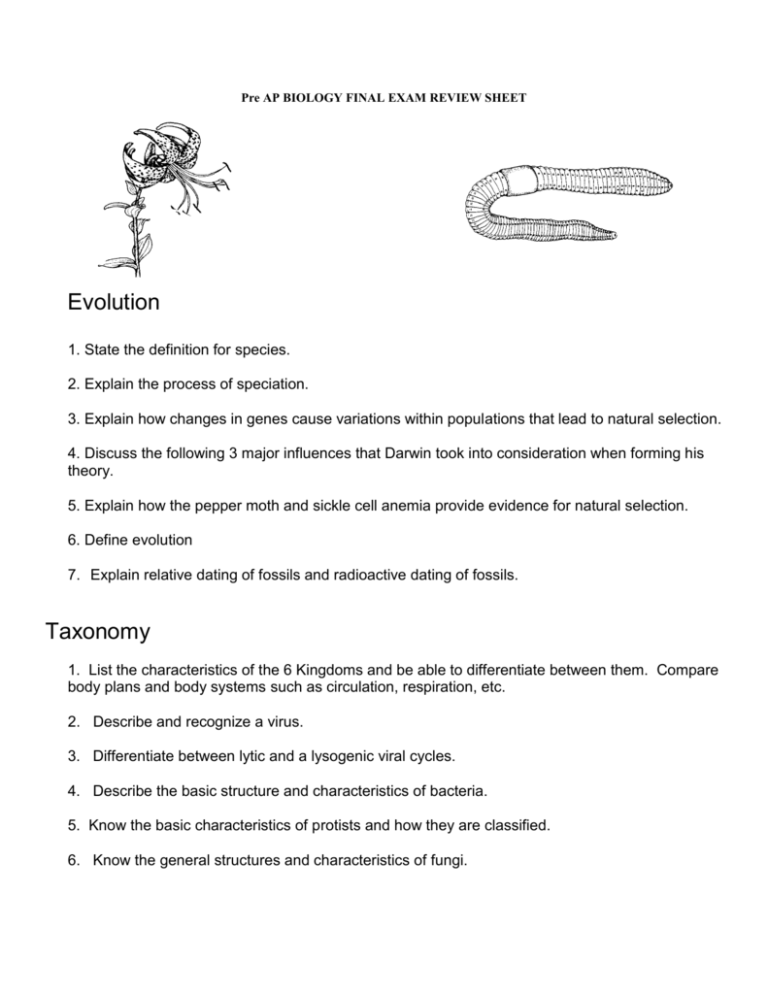
Pre AP BIOLOGY FINAL EXAM REVIEW SHEET Evolution 1. State the definition for species. 2. Explain the process of speciation. 3. Explain how changes in genes cause variations within populations that lead to natural selection. 4. Discuss the following 3 major influences that Darwin took into consideration when forming his theory. 5. Explain how the pepper moth and sickle cell anemia provide evidence for natural selection. 6. Define evolution 7. Explain relative dating of fossils and radioactive dating of fossils. Taxonomy 1. List the characteristics of the 6 Kingdoms and be able to differentiate between them. Compare body plans and body systems such as circulation, respiration, etc. 2. Describe and recognize a virus. 3. Differentiate between lytic and a lysogenic viral cycles. 4. Describe the basic structure and characteristics of bacteria. 5. Know the basic characteristics of protists and how they are classified. 6. Know the general structures and characteristics of fungi. Ecology 1. Know the water cycle, carbon cycle, nitrogen cycle, and oxygen cycle. 2. Be able to explain how energy flows and nutrients are recycled through ecosystems. 3. Know why energy pyramids and food chains typically only have 3 or 4 trophic levels. 4. Know the type of organisms at each trophic level in a food chain, food web and on an energy pyramid. 5. Know how to read, interpret, and construct food chains, food webs, energy pyramids. 6. Be able to interpret exponential and logistic growth curves. 7. Know the characteristics of the major biomes. 8. Be able to calculate population density Plants 1. Describe the differences between nonvascular and vascular plants. 2. Compare sporophyte and gametophyte generations in the lifecycle of a plant. 3. What are the differences between xylem and phloem. (structure, function, in roots, in stems) 4. Know what adaptations seed plants had to have to survive life on land. 5. Know the structure and functions of roots, stems, and leaves. 6. Describe the characteristics of gymnosperms and be able to give specific examples. 7. Describe the characteristics of angiosperms and be able to give specific examples. 8. Make a chart comparing monocots and dicots. 9. Draw a flower and list the function of each of its parts. 10. Describe how pollination can occur? 11. What are methods of seed dispersal? 12. Know the various plant pigments and what they do. 13. What nutrients are required for growth of a plant? 14. List the plant hormones and tell the effects of each on the plant. 15. Draw a leaf cross section, label the parts, and tell the function of each. 16. Define geotropism, thigmotropism, and phototrophism. Animals 1. Be able to name and describe all the invertebrate animal phyla studied and all the vertebrate classes. 2. Know the characteristic organisms found in each of the animal phyla and classes studied. 3. What are the different types of metamorphosis? Describe each. 4. Be able to differentiate between fertilization, cleavage, and gastrulation. 5. Know the 3 germ layers and how they develop in the embryological development of animals. 6. Be able to differentiate between the development of a protostome and a deuterostome. 7. What are the types of symmetry. Describe each. 8. What is the difference between acoelomates, pseudocoelomates, and coelomates. 9. Know the characteristics of all chordates. 10. Compare exoskeletons and endoskeletons. 11. Be able to compare and contrast respiration, excretion, digestion, movement, internal transport, reproduction, feeding, etc. in the animals studied. 12. What are the characteristics of the different types of fish studied? 13. What is meant by oviparous, ovoviviparous, viviparous? 14. What are the characteristics of amphibians? Understand why they could not live in arid regions. 15. What specific adaptations do reptiles have that amphibians do not? 16. What is an amniotic egg? Why is it important to reptiles? 17. Compare and contrast the life of ectotherms and endotherms. 18. What are the unique characteristics of birds? 19. What are the unique characteristics of mammals? 20. Know the systems and functions of the organs in the crayfish, perch and pig dissection. Be able to label the structures in the crayfish, perch and pig dissections. Be sure to review all lab material and all notes. Know all word parts.

